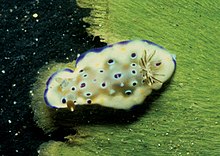Goniobranchus tennentanus
Goniobranchus tennentanus (the gaudy chromodorid) is a species of colourful sea slug in the family Chromodorididae.[2][4]
| Gaudy chromodorid | |
|---|---|
 | |
| Scientific classification | |
| Kingdom: | Animalia |
| Phylum: | Mollusca |
| Class: | Gastropoda |
| Subclass: | Heterobranchia |
| Order: | Nudibranchia |
| Suborder: | Doridina |
| Superfamily: | Doridoidea |
| Family: | Chromodorididae |
| Genus: | Goniobranchus |
| Species: | G. tennentanus |
| Binomial name | |
| Goniobranchus tennentanus | |
| Synonyms[2] | |
Distribution
This species was described from Ceylon (Sri Lanka). It has also been reported from the following locations; East Africa, East Coast of South Africa, Tanzania and Chagos.
Description
Kelaart's original description is as follows:
Body 1 inch long, white. Mantle white, with a faint bluish shade, and spangled with golden-coloured and purple spots. Margin caerulean blue. Dorsal tentacles clavate, purplish red, tipped with white, laminated. Branchial plumes red, numerous, 12 to 15, linear, bipinnated. Foot white, upper surface spotted with yellow. Oral tentacles white, with a yellow margin. Under surface of mantle white, with bluish reflexions.
Eliot's Chromodoris vicina is described as follows:
Mantle and foot bordered with light violet, the latter border a row of dots. Middle of back drab-brown with bright violet spots, the larger ones with a white centre. Near the edge of the mantle a number of yellow spots with white borders, which are often confluent. The foot deep and narrow, white with some yellow spots near the lower edge. The rhinophores dark brown with white tips. Each of the branchiae bore two black bands.
Most of the specimens identified as G. tennentanus are a good fit for Eliot's description of C. vicina, but it is possible that it is not really a synonym of G. tennentanus. In particular G. tennentanus is described as having a continuous sky blue margin, not purple, and red gills. C. vicina is up to 40 mm (1.6 in) long, with central region orange brown, mottled with lighter and darker patches and with dark purple spots, some with white centres, surrounded by white rings. The central area is surrounded by an irregular cream band which contains bright yellow spots. The margin is purple and somewhat discontinuous or broken into elongate spots.[5][6][7]
Similar species
This species has been confused with Goniobranchus cavae but differs in having yellow spots only within the cream band at the edge of the mantle, whilst in G. cavae these spots are all over the back.[5][8]
Habitat
Habitat: diverse, among shallow coral reefs.[2][9]
References
- Kelaart, E. F. 1859. On some additional species of nudibranchiate mollusks from Ceylon. Annals & Magazine of Natural History, series 3, 4(22):267-270, p. 268.
- Bouchet, P. (2015). Goniobranchus tennentanus (Kelaart, 1859). In: MolluscaBase (2015). Accessed through: World Register of Marine Species on 2015-11-14
- Eliot, C. N. E. (1904). On some nudibranchs from East Africa and Zanzibar, part IV. Proceedings of the Zoological Society of London. 1904:1:380, page 392
- Johnson R.F. & Gosliner T.M. (2012) Traditional taxonomic groupings mask evolutionary history: A molecular phylogeny and new classification of the chromodorid nudibranchs. PLoS ONE 7(4): e33479
- Rudman, W.B., 1999 (November 8) Chromodoris tennentana (Kelaart, 1859). [In] Sea Slug Forum. Australian Museum, Sydney.
- Debelius, H. & Kuiter, R.H. (2007) Nudibranchs of the world. ConchBooks, Frankfurt, 360 pp. ISBN 978-3-939767-06-0 page(s): 164
- Gosliner, T.M., Behrens, D.W. & Valdés, Á. (2008) Indo-Pacific Nudibranchs and seaslugs. A field guide to the world's most diverse fauna. Sea Challengers Natural History Books, Washington, 426 pp. page(s): 221
- Rudman, W.B. (1987). The Chromodorididae (Opisthobranchia: Mollusca) of the Indo-West Pacific: Chromodoris epicuria, C. aureopurpurea, C. annulata, C. coi and Risbecia tryoni colour groups. Zoological Journal of the Linnean Society 90 (3): 305-407. page(s): 364
- Branch, G.M. et al. (2002). Two Oceans. 5th impression. David Philip, Cape Town & Johannesburg.